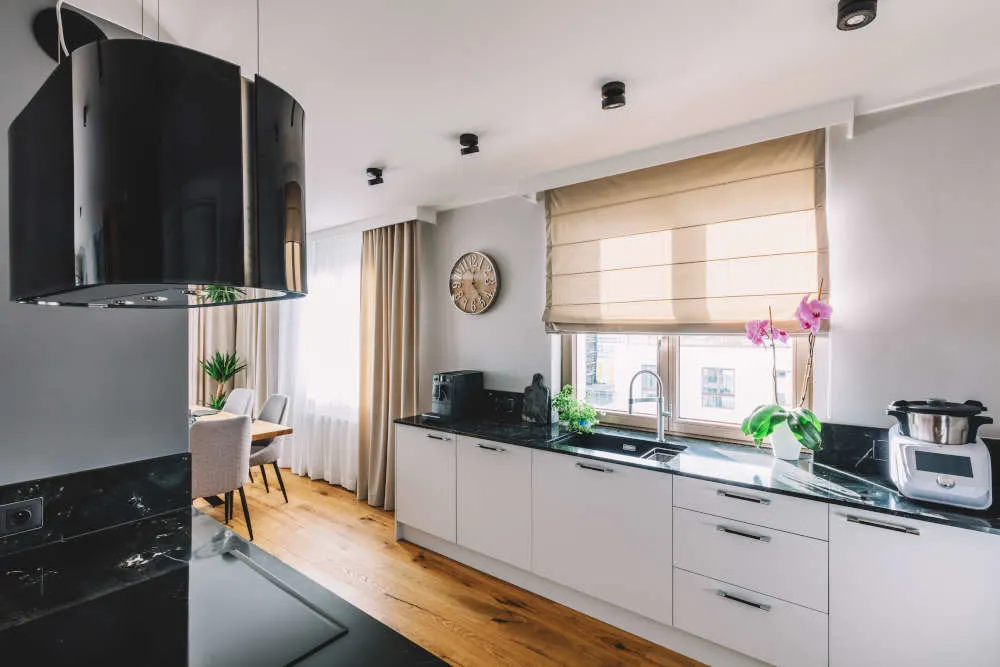Bathrooms and kitchens are arguably two of the most important rooms in any home. They are also the two most heavily plumbed rooms, so having them next to each other can be very convenient. However, when you consider the activities of a kitchen and a bathroom, it is logical to wonder if there are any codes or guidelines regarding their proximity.
The IRC does not refer to installing a bathroom and a kitchen next to each other. General practice follows the UK Building Regulations, which say that a bathroom can be next to a kitchen provided they are separated by a door.
Let’s look at the official rules and guidelines regarding the question of locating a bathroom next to the kitchen. Then we will discuss the possible benefits of this arrangement as well as the arguments against it.
What Do the Building Codes Say

The International Residential Code (IRC) is the primary building code outlining the rules you need to follow when building a new home or adding to an existing one. The IRC does not state that a bathroom and kitchen cannot be located next to each other; it does not refer to this matter at all.
However, while the IRC standards have been adopted in all 50 states, many states have made adaptations or added their own requirements, so it’s important to research your state’s building codes before placing a bathroom next to your kitchen.
The UK’s Building Regulations stipulate in section 4.10 that:
“A place containing a sanitary convenience [i.e., a toilet] and/or associated hand washing facilities should be separated by a door from any place used for the preparation of food (including a kitchen).”
Worldwide, this seems to be the most commonly accepted practice, and bathrooms and kitchens can be next to each other, provided there is at least one door between the two.
Another common guideline that many contractors follow is only to install a bathroom next to the kitchen if the bathroom has its own washbasin. This makes logical and hygienic sense.
Now that you know you can put the bathroom next to the kitchen, let’s talk about if you should do it.
Advantages of Being Able to Put a Bathroom Next to the Kitchen
Plumbing
All components of a bathroom, toilet, sink, shower, and bathtub, require water lines bringing clean water to the bathroom and sewer lines removing waste. These lines are also needed in the kitchen to supply water and remove the waste from a sink or dishwasher.
While a bathroom and kitchen will have different plumbing requirements, there is a point at which they can link up, and having the bathroom and the kitchen next to each other means that you can save on piping.
Furthermore, you will only have to dig up one section of your yard if you need to replace or repair the pipes!
Convenience
Whether you have kids who wait until their eyes are swimming to tell you they need the toilet, or you just hate traipsing upstairs while you are in the middle of cooking, having a bathroom downstairs, or at least nearer to the living area, is extremely convenient.
If the only place for a downstairs bathroom is next to the kitchen, then being allowed to install the bathroom in this location is advantageous.
Furthermore, there is often more likely to be space for a downstairs bathroom next to the kitchen as opposed to next to the living room or dining room.
Accessibility
There are many homes where a downstairs bathroom is necessary for elderly residents or residents who use wheelchairs who are unable to ascend the stairs with ease (or at all).
If there is no other viable space for a downstairs bathroom, then being permitted to install a bathroom next to the kitchen can contribute immensely to the quality of life of these people.
Disadvantages of Putting a Bathroom Next to the Kitchen

Unpleasant Odors
The most obvious downside to putting your bathroom next to your kitchen is the chance of bathroom odors permeating throughout your kitchen. Not only is this undesirable, but it can also become unhygienic.
Even if your bathroom has an extractor fan, this does not guarantee that no smells will reach the kitchen. There is also the chance of sewer pipes bursting right outside your kitchen or drain blockages creating an ambient and unpleasant aroma.
Keeping the Bathroom Door Closed
When your bathroom is next to your kitchen, you are far more likely to keep the door closed even when the bathroom is not in use.
If the bathroom is just a toilet and basin, then this should not be an issue. However, if the bathroom also contains a bath or shower that is frequently used, then the practice of keeping the door shut can lead to some serious problems.
Walking Through Kitchen to Reach Bathroom
If your bathroom is adjacent to the kitchen, or if the kitchen is part of an open plan design and you do not actually have to walk through the kitchen to reach the bathroom, then this design is more “user-friendly”.
However, a bathroom located at the far end of a non-open plan kitchen does not make logical sense and can be off-putting for guests and potential buyers if you are trying to sell the house.
It will also increase the traffic through the kitchen, which can be frustrating or even dangerous in a smaller kitchen.
Lowering House Sale Price
Mira Showers conducted a very interesting survey on the importance of bathrooms to potential homeowners.
They questioned over 1000 UK citizens, and their results regarding bathrooms accessed through the kitchen shows just how this arrangement could influence the sale of your house.
They found that almost 50% of buyers would offer an average of £7,077.84 (approximately $9,795.84) less than the asking price for a house with a bathroom accessed through the kitchen. Furthermore, over 33% said that they would put down an offer for such property at all.
While your house needs to work for you, you also have to consider the impact that any renovations will have on future sales. If you are going to be investing money into your house, you would prefer to see a return on it.
Recommendations for Bathrooms That Are Next to the Kitchen
- Ensure that your bathroom exhaust fan has a sufficient capacity for the size of the bathroom. You can see what size fan you need using this CFM calculator.
- Keep the fan well-serviced and in optimal working order at all times.
- Preferably install only a toilet and basin so that the door can be kept closed.
- The door should fit well and act as an effective barrier between the kitchen and the bathroom.
- If there is a shower or bath, ensure that a window can be left open or make use of a dehumidifier for supplementary moisture removal.
- The shared wall should be well-insulated to prevent the transference of odors.
Sources
https://homex.com/ask/are-kitchen-and-bathroom-pipes-connected
https://codes.iccsafe.org/content/IRC2018/chapter-3-building-planning
https://www.quora.com/Should-a-bathroom-be-placed-near-a-kitchen-in-a-home-Why-or-why-not
https://www.houzz.com/discussions/2304655/bathroom-off-a-kitchen-yes-or-no-new-house-plan
https://www.mirashowers.co.uk/blog/trends/the-value-of-a-bathroom-mira-campaign/
